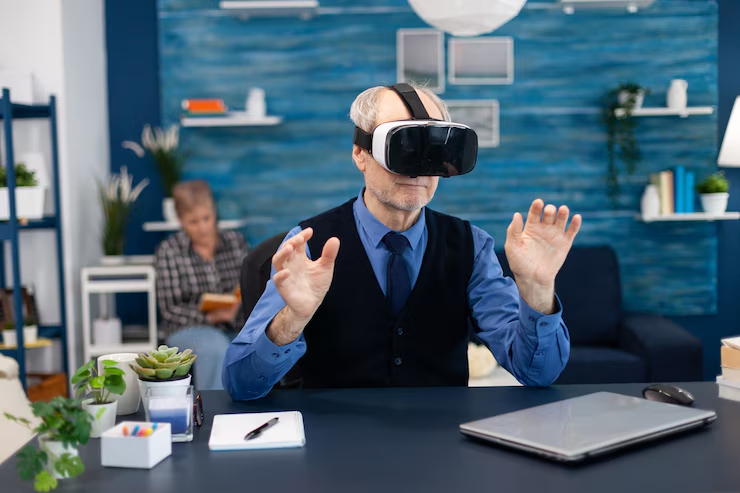
The world of architecture is undergoing a seismic shift, and at the forefront of this transformation is Daniel R. Locke, a visionary architect whose work with Virtual AIA (Architectural Immersive Analytics) is redefining how we design, visualize, and collaborate on building projects. By blending cutting-edge technologies like artificial intelligence (AI), virtual reality (VR), and augmented reality (AR), Locke’s Virtual AIA approach is not only enhancing the creative process but also making architecture more accessible, efficient, and sustainable. In this article, we’ll dive deep into Locke’s contributions to Virtual AIA, explore how his innovative techniques are shaping the future of architecture, and uncover the tools and philosophies driving this revolution.
Who Is Daniel R. Locke?
Daniel R. Locke is a name synonymous with innovation in the architectural world. With a robust background in both traditional architecture and computer science, Locke has carved a unique niche by merging these disciplines to push the boundaries of design. His journey began with a deep-rooted passion for classic architectural principles—think timeless structures and meticulous craftsmanship. However, as digital technologies began to permeate industries, Locke saw an opportunity to integrate AI and virtual tools to elevate the architectural process.
Unlike many architects who remain anchored to conventional methods, Locke’s curiosity led him to explore how emerging technologies could enhance design visualization, streamline workflows, and foster global collaboration. His work with Virtual AIA, a platform that combines AI, VR, and AR to create immersive architectural experiences, has positioned him as a thought leader in the industry. Locke’s philosophy is simple yet profound: technology should amplify creativity, not replace it. This mindset has guided his contributions to Virtual AIA, making architecture more dynamic and inclusive than ever before.
What Is Virtual AIA?
Virtual AIA, or Architectural Immersive Analytics, is a groundbreaking approach that leverages advanced technologies to transform how architects conceptualize, design, and present projects. At its core, Virtual AIA integrates:
-
Artificial Intelligence (AI): To automate repetitive tasks, optimize designs, and provide data-driven insights.
-
Virtual Reality (VR): To create immersive 3D environments where architects and clients can “walk through” designs before construction begins.
-
Augmented Reality (AR): To overlay digital designs onto real-world spaces, enhancing visualization and decision-making.
-
Machine Learning (ML): To analyze vast datasets and suggest improvements in energy efficiency, structural integrity, and aesthetics.
-
Natural Language Processing (NLP): To enable more intuitive interactions between architects and virtual assistants or design tools.
This fusion of technologies allows architects to move beyond traditional blueprints and 2D renderings, creating interactive, real-time design experiences that enhance collaboration and precision. Virtual AIA is not just a tool—it’s a paradigm shift that empowers architects to explore new creative horizons while addressing practical challenges like cost, sustainability, and accessibility.
The Evolution of Virtual AIA
The concept of Virtual AIA didn’t emerge overnight. It’s the result of decades of advancements in computer graphics, AI algorithms, and simulation technologies. In the early 2000s, tools like AutoCAD and Revit revolutionized digital drafting, but they were still limited to 2D or basic 3D models. The rise of cloud-based platforms and high-performance computing in the 2010s paved the way for more sophisticated tools, enabling real-time collaboration and immersive visualizations.
Daniel R. Locke entered this landscape with a vision to take these technologies further. By integrating AI-driven analytics and VR/AR experiences, he created a framework where architects could not only design but also test and refine their ideas in a virtual environment. This approach has made Virtual AIA a game-changer, particularly in an era where remote work and global collaboration are increasingly vital.
How Daniel R. Locke Is Shaping Virtual AIA
Locke’s contributions to Virtual AIA are multifaceted, blending technical expertise with a deep understanding of architectural needs. Here’s a closer look at how he’s driving this revolution:
1. Pioneering AI-Driven Design Optimization
One of Locke’s most significant contributions is his use of AI to enhance the design process. Through predictive analytics and machine learning, Virtual AIA can analyze vast amounts of data—such as material costs, environmental impact, and structural requirements—to suggest optimized designs. For example, AI can recommend energy-efficient materials or identify potential structural weaknesses before construction begins, saving time and resources.
2. Enhancing Visualization with VR and AR
Locke’s integration of VR and AR into Virtual AIA allows architects and clients to experience designs in ways previously unimaginable. With VR, stakeholders can virtually “walk through” a building, exploring every detail from the texture of the walls to the play of natural light. AR takes this a step further by overlaying digital designs onto physical spaces, enabling real-time adjustments during site visits.
3. Fostering Global Collaboration
In a world where architectural teams are often spread across continents, Locke’s Virtual AIA platform facilitates seamless collaboration. Cloud-based tools and real-time data sharing allow architects, engineers, and clients to work together in a shared virtual space, regardless of their location. This has broken down geographical barriers, making it easier for diverse teams to contribute to projects.
4. Promoting Sustainability and Accessibility
Locke’s work emphasizes sustainable design practices. Virtual AIA’s AI tools can analyze a building’s environmental impact, suggesting ways to reduce energy consumption or incorporate renewable materials. Additionally, Locke is a strong advocate for accessibility, ensuring that virtual environments are inclusive and user-friendly for architects and clients of all skill levels.
5. Simplifying Complex Workflows
By automating routine tasks like drafting, measurements, and compliance checks, Virtual AIA frees architects to focus on creativity. Locke’s platform integrates with industry-standard software like Autodesk Revit and SketchUp, streamlining workflows and reducing errors.
Table 1: Key Technologies in Daniel R. Locke’s Virtual AIA
|
Technology |
Function |
Benefit |
|---|---|---|
|
Artificial Intelligence |
Automates design optimization and predictive analytics |
Reduces costs, enhances efficiency, and improves sustainability |
|
Virtual Reality |
Creates immersive 3D environments for design exploration |
Enhances visualization and client engagement |
|
Augmented Reality |
Overlays digital designs onto real-world spaces |
Enables real-time adjustments and better decision-making |
|
Machine Learning |
Analyzes data to suggest design improvements |
Improves structural integrity and energy efficiency |
|
Natural Language Processing |
Enables intuitive interactions with design tools and virtual assistants |
Simplifies user experience and enhances collaboration |
The Impact of Virtual AIA on the Architecture Industry
Daniel R. Locke’s Virtual AIA is not just a technological innovation—it’s a catalyst for broader changes in the architecture industry. Here are some of the ways it’s making a difference:
1. Enhanced Client Engagement
Clients no longer have to rely on flat blueprints or static renderings to understand a design. With Virtual AIA, they can immerse themselves in a 3D model, providing feedback that’s more informed and actionable. This leads to better alignment between architects and clients, reducing costly revisions.
2. Cost and Time Savings
By identifying potential issues early in the design process, Virtual AIA minimizes the need for expensive changes during construction. Automation also speeds up repetitive tasks, allowing projects to stay on schedule and within budget.
3. Sustainability and Efficiency
Virtual AIA’s AI tools help architects design buildings that are more energy-efficient and environmentally friendly. For example, simulations can predict how a building will perform under different weather conditions, enabling architects to optimize insulation or window placement.
4. Global Reach and Inclusivity
Virtual AIA events and platforms, championed by Locke, make architectural education and networking accessible to professionals worldwide. Whether you’re in a small town or a bustling city, you can participate in workshops, seminars, and collaborative projects without the need for travel.
5. Future-Proofing the Industry
As technologies like blockchain and advanced AI algorithms emerge, Locke’s Virtual AIA is poised to integrate these innovations, ensuring that architects stay ahead of the curve. For instance, blockchain could be used for secure project tracking, while AI could further refine design analytics.
Table 2: Benefits of Virtual AIA for Architects and Clients
|
Aspect |
Traditional Architecture |
Virtual AIA |
|---|---|---|
|
Design Visualization |
2D blueprints, static 3D renderings |
Immersive VR/AR experiences |
|
Collaboration |
In-person meetings, limited by geography |
Global, real-time collaboration via cloud-based platforms |
|
Cost Efficiency |
Higher risk of costly revisions |
Early issue detection, automation reduces costs |
|
Sustainability |
Limited environmental analysis |
AI-driven insights for energy efficiency and sustainable materials |
|
Accessibility |
Restricted to those who can attend in-person events |
Inclusive virtual platforms for global participation |
Daniel R. Locke’s Philosophy and Vision
At the heart of Locke’s work is a belief that technology should serve as a bridge between art and science. He views Virtual AIA as a tool to amplify human creativity, not replace it. His philosophy emphasizes:
-
Continuous Innovation: Locke is always exploring new technologies, from advanced AI algorithms to VR headsets, to push the boundaries of what’s possible in architecture.
-
Inclusivity: By making Virtual AIA accessible to architects of all skill levels and backgrounds, Locke is democratizing the design process.
-
Sustainability: Locke advocates for designs that prioritize environmental responsibility, using AI to minimize a building’s carbon footprint.
-
Collaboration: Virtual AIA fosters a sense of community, enabling architects to share ideas and learn from one another in a digital space.
This philosophy is evident in Locke’s writing and speaking engagements, where he often discusses the ethical implications of AI in design and the importance of creating spaces that promote human well-being.
Tools and Technologies Powering Virtual AIA
Virtual AIA relies on a suite of advanced tools and technologies, many of which Locke has championed or refined. Here’s a closer look at some of the key components:
1. Industry-Standard Software
Virtual AIA integrates seamlessly with tools like:
-
Autodesk Revit: For Building Information Modeling (BIM) and 3D design.
-
AutoCAD: For precise 2D and 3D drafting.
-
SketchUp: For quick, intuitive 3D modeling.
-
Lumion: For high-quality rendering and visualization.
2. AI and Machine Learning
AI algorithms analyze design data to suggest improvements, optimize workflows, and predict project outcomes. For example, machine learning can assess a building’s energy performance based on historical data and environmental factors.
3. VR and AR Platforms
Tools like Oculus Rift, HTC Vive, and Microsoft HoloLens enable immersive VR and AR experiences. These platforms allow architects to create realistic simulations and overlay digital designs onto physical spaces.
4. Cloud-Based Collaboration Tools
Platforms like BIM 360 and Google Workspace enable real-time collaboration, allowing teams to share designs, track progress, and communicate seamlessly.
5. Natural Language Processing (NLP)
NLP-powered virtual assistants can interpret voice commands, answer questions, and assist with design tasks, making the process more intuitive for users.
Challenges and Future Directions
While Virtual AIA offers immense potential, it’s not without challenges. Locke himself has acknowledged some of the hurdles architects face when adopting these technologies:
-
Digital Literacy: Not all architects are comfortable with advanced tools, requiring training and support to bridge the gap.
-
Access to Technology: High-speed internet and powerful hardware are essential for Virtual AIA, which can be a barrier in some regions.
-
Virtual Fatigue: Prolonged use of virtual platforms can lead to exhaustion, necessitating user-friendly interfaces and breaks.
Looking ahead, Locke envisions a future where Virtual AIA becomes even more sophisticated. Emerging technologies like blockchain for secure project tracking and advanced AI for predictive modeling are on the horizon. Additionally, the integration of virtual reality with haptic feedback could create even more immersive design experiences, allowing architects to “feel” textures and materials in a virtual space.
Case Studies: Virtual AIA in Action
To illustrate the impact of Locke’s Virtual AIA, let’s explore a few real-world examples:
1. Urban Redevelopment Project
A city planning team used Virtual AIA to redesign a historic district. By creating a VR model, stakeholders could explore proposed changes, ensuring that new structures complemented the area’s heritage while meeting modern sustainability standards. AI analytics helped optimize building placement to maximize natural light and reduce energy consumption.
2. Residential Design Collaboration
An international team of architects used Virtual AIA to collaborate on a luxury residential project. Cloud-based tools allowed real-time updates, while VR walkthroughs enabled the client to provide feedback from thousands of miles away. The project was completed 20% faster than traditional methods, with significant cost savings.
3. Educational Workshops
Locke’s Virtual AIA platform hosted a series of online workshops for architecture students, allowing them to interact with 3D models and learn from industry experts. The accessibility of the platform enabled students from remote areas to participate, fostering a new generation of tech-savvy architects.
Why Daniel R. Locke Stands Out
With so many architects embracing technology, what makes Locke’s approach unique? It’s his ability to blend technical expertise with a deep understanding of architectural artistry. His work doesn’t just focus on efficiency—it’s about creating spaces that inspire and uplift. By prioritizing inclusivity, sustainability, and collaboration, Locke is not just shaping buildings but also the future of the profession.
Additionally, Locke’s writing and speaking engagements, such as his articles on Virtual AIA’s blog, make complex technological concepts accessible to a broad audience. His ability to demystify AI and VR has inspired countless architects to embrace these tools, ensuring that the industry continues to evolve.
FAQ: Daniel R. Locke and Virtual AIA
What is Daniel R. Locke’s role in Virtual AIA?
Daniel R. Locke is a leading figure in Virtual AIA, driving its development by integrating AI, VR, and AR into architectural practices. He focuses on enhancing design visualization, collaboration, and sustainability through innovative technologies.
How does Virtual AIA improve architectural design?
Virtual AIA uses AI to optimize designs, VR for immersive visualizations, and AR for real-world overlays, resulting in more efficient, accurate, and creative design processes.
Can Virtual AIA be used by architects of all skill levels?
Yes, Virtual AIA is designed to be user-friendly, with intuitive interfaces and guides to help architects, from beginners to experts, adopt the platform effectively.
What are the benefits of Virtual AIA for clients?
Clients benefit from immersive VR walkthroughs, cost savings through early issue detection, and sustainable designs that align with environmental goals.
How does Virtual AIA support global collaboration?
By leveraging cloud-based platforms, Virtual AIA enables architects, engineers, and clients worldwide to collaborate in real-time, breaking down geographical barriers.
What tools does Virtual AIA integrate with?
Virtual AIA integrates with industry-standard tools like Autodesk Revit, AutoCAD, SketchUp, and Lumion, as well as VR/AR platforms like Oculus Rift and Microsoft HoloLens.
How is Daniel R. Locke addressing challenges in Virtual AIA adoption?
Locke is focused on improving digital literacy through training, ensuring equitable access to technology, and designing user-friendly interfaces to combat virtual fatigue.








